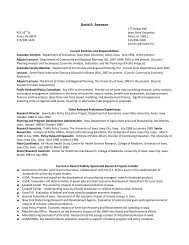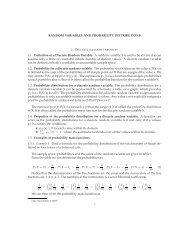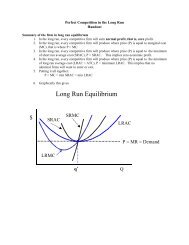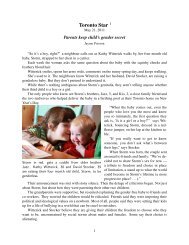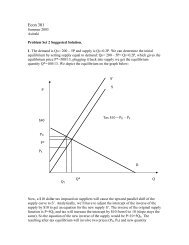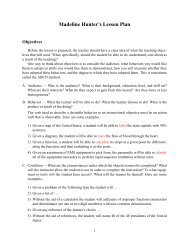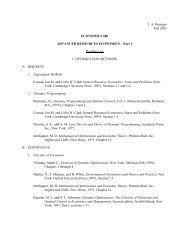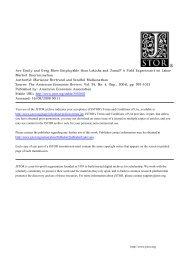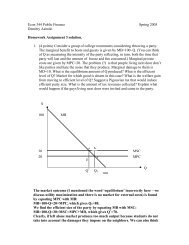SAMPLE MOMENTS 1.1. Moments about the origin (raw moments ...
SAMPLE MOMENTS 1.1. Moments about the origin (raw moments ...
SAMPLE MOMENTS 1.1. Moments about the origin (raw moments ...
Create successful ePaper yourself
Turn your PDF publications into a flip-book with our unique Google optimized e-Paper software.
4 <strong>SAMPLE</strong> <strong>MOMENTS</strong>3.2.2. Variance of C r n. First consider <strong>the</strong> case where we have a sample X 1 ,X 2 , ... ,X n .(Var( Cn r 1n∑ ()=Var Xi − µ ′ i,1ni=1If <strong>the</strong> X’s are independently distributed, <strong>the</strong>nVar( C r n )= 1 n 2n ∑i=1If <strong>the</strong> X’s are independent and identically distributed, <strong>the</strong>n) r)= 1 n 2 Var ( n∑i=1Var [( X i − µ ′ ) r ]i,1)(Xi − µ ′ ) ri,1(21)(22)Var( Cn r )= 1 n Var[ ( X − µ ′ 1 ) r ] (23)where X denotes any one of <strong>the</strong> random variables (because <strong>the</strong>y are all identical). In <strong>the</strong> case where r =1,we obtainVar ( Cn1 ) 1 =n Var[ X − µ′ 1 ]= 1 n Var[ X − µ ]= 1 (24)n σ2 − 2 Cov[ X, µ]+Var[ µ ]= 1 n σ24. <strong>SAMPLE</strong> ABOUT THE AVERAGE4.1. Definitions. Assume <strong>the</strong>re is a sequence of random variables, X 1 ,X 2 ,...X n . Define <strong>the</strong> rth samplemoment <strong>about</strong> <strong>the</strong> average asm r nMnr = 1 n∑ (Xi −n¯X) rn , r =1, 2, 3,..., (25)i=1This is clearly a statistic of which we can compute a numerical value. We denote <strong>the</strong> numerical value by,, and define it asmIn <strong>the</strong> special case where r = 1 we haver n = 1 nn∑( x i − ¯x n ) r (26)i =1Mn 1 = 1 n= 1 nn∑ (Xi − ¯X)ni =1n∑X i − ¯X ni =1= ¯X n − ¯X n = 0(27)4.2. Properties of Sample <strong>Moments</strong> <strong>about</strong> <strong>the</strong> Average when r = 2.



